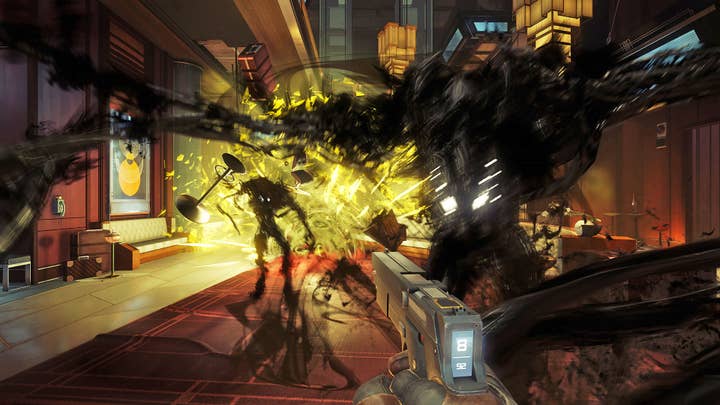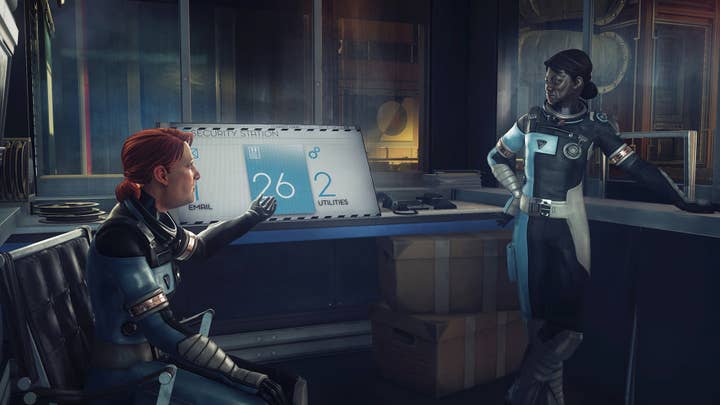Critical Consensus: Prey
Only Yu can save mankind
Arkane's Prey has had a tough start. Already set a stern target by being measured against the likes of System Shock, BioShock and the studio's own Dishonored, the space-based immersive sim struggled in its week-one sales, at least in the UK, losing out to Mario Kart 8 Deluxe for the top slot in the boxed releases chart.
Many have diagnosed these figures as a symptom of Bethesda's ongoing policy of not sending out review code until the day before release, believing that consumers prefer to read professional reviews conducted at a sensible pace before buying, particularly given that both Doom and Dishonored 2 also saw similarly slow first weeks.
Both of those games had a less precipitous drop-off in second and third weeks than similar titles, and also received considerable critical acclaim once reviews did appear, so Prey may still see the same sort of long tail. Nonetheless, there's no doubt that Bethesda's reasoning for the policy still rings a little hollow.
It also makes these article a pain in the proverbial, as, nearly a week after release, several major outlets still don't have a review published. There are, however, enough assessments out there to have a decent stab at establishing a Critical Consensus - just don't expect the usual contributions from some of the bigger consumer sites such as IGN or Polygon.

All that said, Prey comes off pretty well in the first round of critiques, posting Metacritic averages of 80, 83 and 88 on PS4, PC and Xbox One at the time of writing. In a topline summary, consistent praise goes to the writing (due in no small part to the input of Chris Avellone) and thematic pillars, as well as some of the more interesting mechanics. Response to the set-dressing - a heavily stylised mix of '60s and art-deco sci-fi - has been less unanimous, whilst combat has generally been identified as the game's weak point, although it's also acknowledged to be something which the game prompts you to avoid, or at least think creatively about, whenever possible.
Writing for Eurogamer in a review that awards Prey 'Recommended' status, Edwin Evans-Thirlwell expresses his admiration for the stylish confines of Talos-1, the space station where the game takes place, even to the point of regretting any furniture rearrangement which takes place during firefights or the search for elusive items.
"It's an absurdly magnificent edifice," he says of Talos-1, "perhaps the grandest and most beautiful facility of its kind ever imagined for a game, though coming from the art team behind Dishonored 2, this is hardly unexpected. Every chamber, blind corner or overlook is a mesmerising study in light, colour, texture and period detailing."
Alongside his enjoyment of Arkane's feng shui sensitivities, there's a healthy line of respect in the Eurogamer review for one of the game's central concepts - the collection and subsequent recycling of mundane environmental objects.
"You'll squint at innocent-looking pairs of objects, take careful aim at one of them and wind up your melee attack, only for an unsuspected desk lamp to hurl itself screeching at your face"
Edwin Evans-Thirlwell, Eurgamer
This being a (relatively) non-militarised establishment, the Talos-1 isn't littered with the usual plethora of weaponry and munitions. Whilst players will still stumble across various shooty-bang-bangs in the extensive corridors of the station, most ammunition and other supplies will actually be 3D printed by the player at special fabricator units, fed by the spheres and cubes of elemental material produced by the recycling units. Pretty much anything of a suitable size can be junked and re-used in this fashion, lending an air of even more desperate hoarding to a genre which already sees most players frenetically digging through every shelf, drawer and dustbin they come across.
For Evans-Thirlwell, there's considerable joy in the sheer physicality of the process: an ability to reshape and re-purpose your environment which lends marvellously to the sense of presence and desperate survival, and elicits comparison to another titanic IP: Minecraft.
"...The resulting items don't just materialise in your inventory but cascade from the output hopper," he writes, "a show of pure delight in the illusion of physical matter undergoing magical reassembly."
Supporting his Mojang-ian analogy is the game's signature weapon: the Gloo Gun. Essentially a non-violent weapon which lets the protagonist freeze enemies by encasing them in quick-drying foam, the Gloo Gun also lets players build steps and barriers with gooey chunks, encouraging the circumvention of steep walls and the barricading of choke points. As Evans-Thirlwell observes, it's touches like this which help to distinguish Prey from its many contemporaries, adding a welcome touch of the "weird".

There's another clear trump card in Prey's hand when it comes to individuality, however, and one which featured so heavily in the game's marketing that it's almost a relief when they appear to mark the transition between quasi-tutorial opening and Prey proper: the Mimic.
As its name suggests, the Mimic is a furtive beast with the ability to disguise itself as any object of suitably similar mass, facilitating the paranoia-inducing surprise attacks which are the key driver of protagonist Morgan Yu's crumbling psychology later in the game. Never particularly dangerous as enemies, being quickly dispatched with a swing or two of a hefty wrench, the Mimics nonetheless set the creepy, cautious pace which predominates the game. Writing for the Guardian in a review sitting at the low end of the spectrum, at 3/5, Hirun Cryer notes that the iconic enemies are replaced too soon by something far less gratifying.
"It's a fascinating design concept, often rendering Morgan Yu a paranoid mess, as he frantically attempts to recall whether that mug had been on there on the desk just a second ago, or whether it's about to turn into an alien and attempt to kill them," writes Cryer, before lamenting the introduction of the more advanced 'phantoms' seen later in the game - enemies which posses a suite of abilities which do not encourage enjoyable combat.
"While different varieties of Phantom can shoot bolts of energy, fire, or duplicate themselves entirely," he notes, "all Phantoms can teleport with great speed, and this combined with their generous health pool and the scarcity of ammunition for the player often makes combat more frustrating than tense."
"It's so, so long since a big budget game has felt so fresh, so inspired, so imaginative with the building blocks of Looking Glass's legacy."
John Walker, RPS
The Mimic also encapsulates another of the most enjoyable, and unusual, mechanics of Prey - the ability to take on some of the characteristics of the game's aliens, including shapeshifting. Once the proper "neuromods" are discovered, players can extend one of three skill trees to the point of being able to take on the form of coffee cups, ring binders and plant pots in order to hide from enemies or squeeze through small gaps. However, taking on too many alien attributes will cause the station's defence systems to identify Yu as an intruder and open fire. A risk/reward pay-off, but one which Cryer feels is unduly harsh, to the extent that it "feels like Prey severely punishing the player for harnessing the abilities that are undoubtedly the most fun to use."
Over at Rock, Paper, Shotgun, Prey finds John Walker in an uncharacteristically ebullient mood, calling it a "a truly fantastic game". Although he warns readers not to expect much of a similarity to the 2006 original, he also quickly establishes this as a Good Thing, praising Prey's ability to turn many genre conventions on their heads and force new ways of thinking and play from its players.
Again praising the sense of place bestowed by the excellent level design, Walker references the Metroidvania-style unlocking of areas with tools and abilities which lies at the core of the game's pacing and exploration. However, whilst the collection of these faculties is generally cause for, at very least, a catchy trumpet sting in most games, in Prey their discovery often seems almost entirely unannounced, something which Walker finds pleasantly refreshing.

"I've never seen a game be this relaxed about itself, and it's a huge joy," he writes of the attitude to discovery. "Everything from every major publisher seems so obsessed with enforced fanfares, choreographed sequences and non-interactive cutscenes, to make sure you notice all their hard, hard work. Prey seems completely ambivalent about this, just content with being a brilliant game and letting you notice that for yourself."
He's not so full of admiration for the systems of violence contained in Prey, however, particularly in the early stages when options are largely limited to the liberal application of a literal blunt instrument. In addition, he finds the rapidity which which Yu is exhausted by these activities to be unnecessarily limiting - something which leads him to conclude that "combat, at the start, is bloody awful. Avoidable in the most part, but still awful."
He later notes, however, that "combat definitely improves, but the Mimics never get less annoying. It's definitely the game's weakest aspect, but that's surprisingly unimportant overall... Prey is brilliant, and it's still great right up until moments before its end."
GameInformer's Javy Gwaltney, awarding an 8.25, also notes that the opening hours of Prey don't necessarily paint it in the best light, citing the watershed of obtaining your first Neuromods as the point where the game really finds its feet and opens up its systems. In addition, Gwaltney notes that many of the side quests and optional objectives in the game, often based on the requests of those few of the station's crew who are still alive, have a tangible effect on gameplay, deepening immersion.
"There are a lot of missions like this, asking you to make value judgements about the lives of your crew, the mission at stake, and your own survival. I was surprised at how well I was pulled into the fantasy of being Morgan, having to juggle the needs of the world versus my own."
For Gwaltney, this ability to create a bespoke narrative meshes brilliantly with the open-ended "play it your way" engagements of Prey, synergising into a very satisfying end product - something noted by many other reviewers as well. Back over to Edwin Evans-Thirlwell for his Eurogamer conclusion.
"There's the sense, at times, that Prey is another jumble of exotic raw materials thrown into a Fabricator, a button's touch away from brilliance. But if the chemistry between powers, terrain variables and opponents may fall short of Arkane's best work, the setting's gravity and the charm of certain individual systems is enough to pull you through to the finish. The new Prey began life under a cloud - to be specific, the cloud kicked up by the demise of its Human Head predecessor - but in Talos 1, Arkane has fashioned one of the greatest virtual environments, as ornate and soggy with hubris as BioShock's Rapture, yet far more open-ended. And in the mercurial applications of Mimicking, recycling and the Gloo Gun, there are tantalising hints of something arcane indeed."








